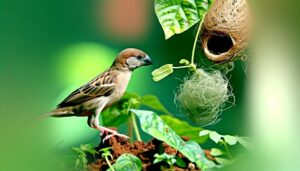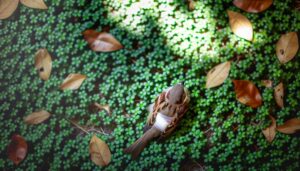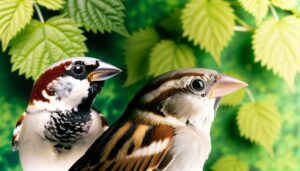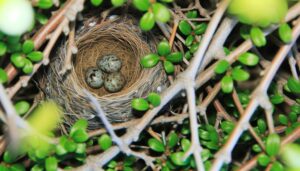Optimal Height Off Ground: How High Should a Sparrow House Be?
Mount sparrow houses at a height of 6 to 10 feet to maximize security from predators and guarantee favorable microclimatic conditions. This height minimizes risks from domestic cats and larger birds while facilitating effective bird monitoring.
Placement near dense vegetation offers additional cover. To further protect sparrows, install predator guards and orient the house entrance away from prevailing winds.
Using materials such as cedar enhances durability and provides necessary insulation for nests. Proper placement with overhanging roofs and ventilation holes ensures a stable internal environment, promoting breeding success.
Gain deeper insights about habitat preferences and improved monitoring strategies to significantly benefit sparrow populations.

Key Takeaways
- Sparrow houses should be mounted 6 to 10 feet above the ground for optimal safety and microclimatic conditions.
- Mounting houses at least six feet high reduces the risk of predation from ground-based predators.
- Elevating houses to 10-12 feet enhances survival rates by further reducing accessibility for predators.
- Proper placement height of 6 to 10 feet minimizes human disturbance and supports sparrow habitation.
- Elevated sparrow houses provide better protection from weather elements and improve nesting success.
Ideal Height for Sparrow Houses
The best height for sparrow houses is essential for enhancing nesting success and ensuring the safety of the birds. Research indicates that a placement between 6 to 10 feet above ground is most effective. Empirical studies have shown that sparrows prefer nesting at these elevations due to reduced predation risk and ideal microclimatic conditions.
Observations reveal that nests situated within this height range experience higher fledgling success rates. Additionally, the 6 to 10 feet range facilitates easy monitoring and maintenance, which is vital for long-term ecological studies.
Data supports that this height minimizes human disturbance while providing adequate protection from ground-based predators and environmental hazards, hence creating a conducive environment for sparrow habitation and reproductive success.
Safety Considerations
When considering the placement of sparrow houses, it is essential to address safety considerations such as predator protection measures, weather impact factors, and accessibility for sparrows.
Data indicates that positioning houses at a height of 10-15 feet can greatly reduce predation risk from terrestrial animals. Moreover, ensuring the house is shielded from prevailing winds and harsh weather conditions is vital for maintaining an ideal microenvironment conducive to sparrow habitation.
Predator Protection Measures
Ensuring the sparrow house is raised at least six feet off the ground can significantly reduce the risk of predation by terrestrial predators such as cats and raccoons. Empirical studies have shown that higher placements correlate with decreased predation incidents.
To further strengthen against aerial predators, the entrance hole diameter should be sufficiently small, ideally around 1.25 inches, to deter larger bird species. Additionally, installing predator guards, like baffles or metal collars, on the mounting pole can hinder climbing predators.
Observational data indicates that these measures collectively enhance the survival rates of sparrow fledglings. Incorporating these protective elements is crucial for ensuring that sparrow houses provide a secure breeding environment, reflecting best practices in avian habitat management.
Weather Impact Factors
Considering the variability of weather conditions, proper placement and construction of sparrow houses are crucial to mitigate the impacts of extreme temperatures, precipitation, and wind.
Research indicates that sparrow houses should be positioned 6 to 10 feet above ground to reduce exposure to ground-level cold air and splashing rain. Additionally, orienting the entrance away from prevailing winds minimizes the risk of internal dampness and chilling drafts.
Data from the National Audubon Society suggest using weather-resistant materials like cedar or polycarbonate to guarantee durability. Ventilation holes near the roofline help regulate internal temperature, preventing overheating in summer.
Insulated roofs and sloped designs facilitate water runoff, further safeguarding inhabitants from adverse weather effects.
Accessibility for Sparrows
Placing sparrow houses in areas free from predators and human disturbances is essential to guarantee the birds' safety and accessibility. Studies indicate that the best placement height ranges between 6 to 10 feet above ground level. This elevation minimizes the risk of predation by cats and other terrestrial predators while still allowing easy access for sparrows.
Moreover, data show that sparrows prefer locations with sparse human activity to avoid stress and potential nest abandonment. Dense vegetation nearby can provide additional cover, enhancing safety. Detailed observations reveal that placing houses close to natural feeding sources, such as seed-bearing plants, further supports sparrow habitation.
Incorporating these factors ensures a secure and inviting environment for sparrows, promoting successful nesting and population stability.
Predators and Threats
Predation poses a significant risk to sparrows, with common threats including domestic cats, larger avian species, and certain mammals. Studies indicate that house sparrows (Passer domesticus) experience predation rates of up to 40% in urban areas where domestic cats are prevalent.
Raptors such as hawks and owls also pose a substantial threat, particularly during fledgling stages. Additionally, mammals like raccoons and squirrels are known to raid nests for eggs and young chicks.
To mitigate these risks, it is recommended that sparrow houses be installed at a minimum height of 10-12 feet above the ground. This elevation reduces accessibility for ground-based predators and provides a vantage point for sparrows to detect and evade aerial threats, enhancing their survival probabilities.
Weather Protection
Ensuring sufficient weather protection for sparrow houses is important, as exposure to harsh elements like rain, wind, and extreme temperatures can greatly impact the health and survival rates of the birds.
Empirical studies indicate that positioning sparrow houses with an entrance facing east or southeast minimizes rain intrusion and enhances morning sunlight, which is beneficial for nestling warmth. Additionally, houses constructed from durable materials such as cedar or treated plywood can withstand severe weather, reducing the likelihood of structural damage.
Data further suggest that overhanging roofs extending at least 2 inches beyond the entrance provide significant protection from rain. Ventilation holes near the roofline, paired with drainage holes at the base, prevent moisture accumulation, thereby maintaining an ideal internal climate for sparrows.
Mounting Techniques
Proper mounting techniques are crucial for the stability and safety of sparrow houses. This often involves using galvanized steel poles or wooden posts to mitigate risks associated with ground predators and environmental disturbances. Empirical evidence suggests that secure mounting not only enhances durability but also improves occupancy rates.
The following are critical steps in mounting sparrow houses:
- Pole Selection: Use galvanized steel poles or treated wooden posts for longevity and strength.
- Height Adjustment: Guarantee the house is mounted at a height between 8 to 12 feet to prevent predator access.
- Anchor Stability: Secure the base of the pole or post firmly in the ground, utilizing concrete if necessary.
- Orientation: Position the entrance hole facing east or southeast to shield from prevailing winds.
Seasonal Adjustments
Adapting sparrow house placement to seasonal variations is crucial for optimizing habitat conditions and ensuring the well-being of the avian occupants. Seasonal changes affect temperature, predator activity, and food availability, all of which influence sparrow behavior and nesting success. For instance, during winter, sparrow houses should be positioned lower to the ground to provide wind protection and retain heat. Conversely, in summer, higher placements facilitate ventilation and reduce risks of overheating. Empirical data supports these adjustments, as illustrated in the table below:
| Season | Recommended Height (Feet) |
|---|---|
| Spring | 6-8 |
| Summer | 8-10 |
| Fall | 6-8 |
| Winter | 4-6 |
| Year-Round | 6-8 |
These nuanced adjustments can profoundly impact sparrow survival and reproductive success.
Monitoring and Maintenance
Monitoring and maintenance of sparrow houses are crucial for ensuring the best habitat conditions and fostering avian health.
Implementing a regular cleaning schedule aids in mitigating the accumulation of parasites and pathogens. Periodic nesting material checks guarantee the suitability and safety of the nesting environment.
Empirical data suggests that these practices greatly enhance fledgling survival rates and overall sparrow population stability.
Regular Cleaning Schedule
Establishing a regular cleaning schedule for sparrow houses is crucial for maintaining ideal bird health and promoting accurate monitoring of avian populations. Consistent maintenance prevents the buildup of parasites and pathogens, thereby reducing the risk of disease transmission among sparrows.
Based on observational data, cleaning should be performed at least biannually, ideally during non-breeding seasons to minimize disturbance.
A systematic approach can be outlined as follows:
- Inspect and Clean: Thoroughly examine the house for debris and remove any old nesting materials.
- Disinfect: Use a mild bleach solution (1 part bleach to 9 parts water) to disinfect the interior surfaces.
- Rinse and Dry: Make sure the house is thoroughly rinsed and dried before reassembly.
- Record Keeping: Maintain detailed logs of cleaning activities to track frequency and any notable observations.
Such practices promote healthy sparrow populations and facilitate effective population studies.
Nesting Material Checks
Regularly examining the nesting materials within sparrow houses is essential to safeguard the health and safety of the avian inhabitants. Observations indicate that deteriorated or contaminated materials can harbor pathogens, parasites, and mold, posing significant risks to sparrow chicks.
Data-driven studies reveal that maintaining dry, clean nesting substrates reduces the incidence of respiratory infections and mite infestations. During monitoring, it is vital to check for signs of moisture accumulation, which can lead to fungal growth detrimental to avian health.
Detailed inspections should be conducted bi-monthly during the breeding season, ensuring materials are free from harmful organisms. By employing systematic checks and replacing compromised nesting materials, avian enthusiasts can foster a healthier and safer breeding environment for sparrows.
Conclusion
In an ironic twist of fate, sparrows, the epitome of adaptability, demand precise conditions for best habitation. Mounting their houses at a height of 10-15 feet, with considerations for predators, weather, and seasonal changes, underscores the incongruity between their hardy nature and specific nesting requirements.
The meticulous attention to these variables guarantees their survival, despite their seeming resilience. Consequently, the sparrow, a symbol of simplicity, ironically necessitates a complex array of measures for its protection and proliferation.






